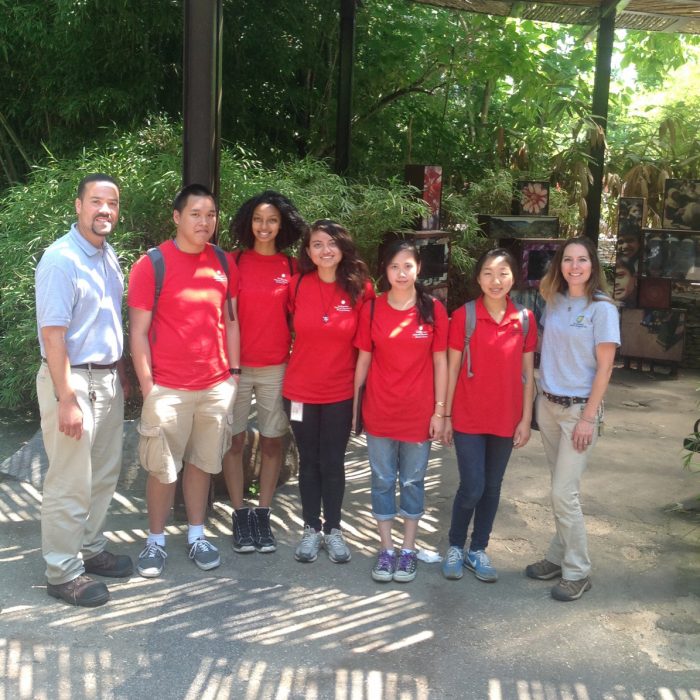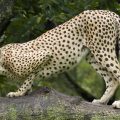A few of my favorite things: Juan Rodriguez
Smithsonian staff work countless hours in the halls of our museums and research centers, in the field, at the Zoo, in our gardens and facilities. We are privileged to spend time with some of the nation’s most cherished treasures as we go about our duties. Sometimes, these unique experiences find a special place in our own personal stories. Amy Kehs introduces Juan Rodriguez and a few of his favorite things.
“For me, luck is preparation meeting the moment of opportunity. There is no luck without you being prepared to handle that moment of opportunity. Every single thing that has ever happened in your life is preparing you for the moment that is to come.”
—Oprah Winfrey
This great quote was running through my head as I talked to Juan Rodriguez, the curator for carnivores at the Smithsonian’s Conservation Biology Institute in Front Royal, Va.. Juan personifies that moment when preparation meets opportunity.
As a small boy growing up in the Washington, D.C. area, Juan Rodriguez often heard from his mother how lucky they were to have the Smithsonian at their doorstep. The free museums gave her, a single mom of three, an amazing opportunity to expose her children to the world around them and beyond. Juan remembers many visits to the museums on the Mall and the National Zoo. One of his favorite memories is playing on “Uncle Beazley,” a life-size fiberglass statue of a triceratops, which sat in front of the National Museum of Natural History when he was little. “Uncle Beazley” represents Juan’s first Smithsonian favorite: he loved the fun he had visiting the museums with his mom and siblings, he loved the inspiration he found in the exhibitions and he especially loved sliding down Uncle Beazley’s tail. The statue was inspired by a children’s book by Oliver Butterworth, The Enormous Egg (1956). The book tells the story of a boy who finds an enormous egg that hatches into a baby triceratops. The triceratops, named Uncle Beazley, becomes too big and the boy brings him to the Smithsonian. In 1994, the statue was moved to the National Zoo where Uncle Beazley and Juan would cross paths again.

Secretary S. Dillon Ripley (1964-1984) and unidentified children with “Uncle Beazley,” the Triceratops model used in the NBC TV film “The Enormous Egg,” at the opening of the Anacostia Neighborhood Museum on September 15, 1967. Uncle Beazley was placed in the parking lot adjoining the Carver Theater, the site of the first Anacostia Museum. Uncle Beazley was later moved to the Mall in front of the National Museum of Natural History and then to the National Zoological Park. (Photo via Smithsonian Institution Archives.)
In high school, Juan was interested in biology and wanted to become a veterinarian. While working as an animal technician in a local vet hospital, Juan heard about a volunteer program at the Smithsonian’s National Zoo. He had no idea that experiences like that existed for someone of his age and he jumped at the chance to apply. In 1997, he started volunteering as an animal keeper aide at the Cheetah Conservation Station. He loved the work, gained valuable experience, met amazing people and was completely dedicated. When a paid employment opportunity came along, his supervisors and mentors encouraged him to apply. The “temporary, not to exceed one year” position allowed him to save for college as he gained experience. When a position opened at the Zoo’s vet hospital toward the end of that year, Juan knew that it was the logical next step, since he still had his sights set on vet school and the experience would be helpful. Juan enjoyed working with the different animals that were treated at the veterinary hospital, but he missed the day-to-day animal husbandry duties of his animal keeper position. He also was surprised at how much he missed talking to the visitors and teaching them about the animals. The realization was a huge “ah-ha” moment and changed the course of his career.
In the spring of 2003 he left the Zoo to pursue a degree in biology. But once again, Juan was prepared when opportunity came knocking. When his mentor and friend, Dr. JoGayle Howard, needed a ride to the airport, Juan offered to help her. During that fortuitous ride, they spent time catching up and she learned about his plans to leave for college. “Well, what are you doing this summer before school starts?” she asked. Before he knew it, Juan was on a plane to Thailand, where he spent the summer as the project manager for Dr. Howard’s field study program at the Thailand Clouded Leopard Consortium. This amazing field experience immersed Juan in a new culture.
After getting his biology degree at George Mason University, Juan returned to the National Zoo in 2006, where he was assigned to the Giant Panda team, so it only makes sense that his second Smithsonian favorite is the giant panda. “This is definitely a hard favorite to pick!” Juan says. “I really love all of the species I work with but my experiences with giant pandas at the National Zoo have been a huge career highlight.” Juan is fascinated by the natural pull that the pandas exert on visitors. He understands that their charisma can help people recognizes the importance of animal conservation. During his tenure on the Panda team, Juan experienced what could probably be called the “Golden Age of Pandas” at the National Zoo. In 2013, the Zoo’s female giant panda, Mei Xiang, was believed to be pregnant again. After several pseudo pregnancies and the birth of a cub that had died after just six days, the team was anxiously awaiting the arrival of what they hoped would be a healthy cub.

Bei Bei and Juan Rodriguez during a weighing session
(Photo courtesy Smithsonian’s National Zoo)
Earlier, Juan and several other members of the team had the opportunity to visit the China Conservation and Research Center in Wolong where they witnessed three giant panda births. Their time in China learning about panda labor, delivery and neonatal care of cubs prepared them for what might be in store, but there was still no way of knowing if Mei Xiang was even pregnant until she gave birth to a roly-poly panda cub just three days after the team returned home. Taking care of baby Bao Bao was the highlight of Juan’s career, until just two years later, along came brother Bei and the panda team had a full house on their hands.
After receiving a master’s degree in leadership in museum education in 2016, Juan moved from the Rock Creek campus of the National Zoo to the Smithsonian Conservation and Biology Institute in Front Royal and took a supervisory role overseeing the care of the carnivores that live there. He currently is responsible for 10 clouded leopards, 11 maned wolves and seven red pandas. At SCBI, Juan has been able to take his love of animal care and education to a different level. SCBI hosts scientists and zoo professionals from all over the world who come to learn how the National Zoo is conserving species through science. Juan enjoys teaching and sharing with his peers but each year he is most excited when the YES! program visits SCBI. The Smithsonian’s Youth Engagement through Science internship experience is Juan’s third Smithsonian favorite. YES!, based at the National Museum of Natural History, is a career immersion and science communication program for youth between the ages of 13 and 19, who are enrolled in under-represented high schools in the Washington, D.C. region. The YES! Program gives teenagers practical experience through hands-on science internships with Smithsonian science staff. Juan helped bring the program to the to the National Zoo in 2011 and in 2012, the Association of Zoos and Aquariums awarded the Zoo the Angela Peterson Excellence in Diversity Award for their work with the YES! Program. A mentor for the program from 2011 until 2014, Juan currently serves as the Zoo’s “YES!” program advisor. Many of the student participants have continued to pursue science as a career. “Giving these kids, who are so much like me at that age, the opportunities and exposure to animal science is really important to me. Inspiring them is investing in the future of animal conservation,” says Juan.

Juan Rodriguez and a group of YES! participants in 2014. (Photo courtesy of Juan Rodriguez)
Juan Rodriguez has spent his life working in a field he loves; he often hears how lucky he is to be surrounded by the amazing animals he works with. But, I think Juan’s preparation and ability to jump at every opportunity is what propelled him to find his passion. “What I love most about the Smithsonian is that my mentors and my supervisors have instilled in me the desire to live up to Smithson’s mission of the ‘increase and diffusion of knowledge,’” Juan says. “When I started at the National Zoo as a volunteer 20 years ago, my sole focus was to just take care of animals. The Smithsonian’s National Zoo showed me that sharing knowledge with the public and our peers helps us do important conservation work. We can do more than just take care of animals—we can save species.”
Posted: 13 April 2018
-
Categories:
Feature Stories , Science and Nature , Zoo & Conservation Biology Institute




